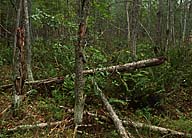The Umeälven River Delta
The large Umeälven River Delta is built up of vast
quantities of sediment from the two mountain rivers, the Umeälven
and the Vindelälven. The active delta encompasses an area
of about 15 square kilometres in both the large Österfjärden
bay north of Obbola and Holmsund and in the smaller Västerfjärden
bay - a separate western riverbed. The land uplift and deposition
of sediment cause the land areas of the delta to change very quickly,
though erosion in the upper portions of the delta also contributes
to extremely large quantities of material being transported in
the water. Calculations show that the rivers deposit as much as
100,000 tonnes of material in the delta annually. Studies of old
maps also show how quickly the currently existing islands in the
delta have formed. The island Stora Tuvan did not even have a
name on a map from 1822; it is only about one hundred metres large.
At almost 1 square kilometre, Stora Tuvan is now one of the biggest
islands in the delta and is covered in lush deciduous forest and
even some spruce on the oldest parts of the island. The most recent
large land areas that formed are a pair of new islands south of
Villanäs, which began to rise out of Österfjärden
during the 1980s. These two islands are currently excellent for
birding.
The Umeälven River Delta also has 200 hectares of
deciduous forests, which are extremely valuable for both birds
and insects, since they are essentially untouched and produce
vast quantities of dead wood.
The delta is probably best known for its wetland birds.
It is one of the areas in Sweden covered by the international
Convention on Wetlands because of its major significance for migratory
wetland birds. Every year vast numbers of geese, ducks and waders
rest here, mainly during the spring migration but also during
the autumn. The geese and ducks usually follow a daily pattern
in which they eat at the Röbäck and Degernäs flatlands
just north of the delta during the day, while resting and washing
in the water of the delta at night. The number of geese usually
peaks in late April and early May, when a few thousand can often
be seen resting on the water and out in the fields. Together with
large flocks of cranes (Grus grus) and
whooper swans (Cygnus cygnus) they make
the area into a true eldorado at this time of year.
In addition to the water areas, the deciduous forests
also host a wealth of bird life. It was therefore not just chance
that this was where the endangered white-backed woodpecker (Dendrocopos
leucotos) carried out its only known Västerbotten
breeding during the 1990s. Other species of woodpeckers that are
content in the deciduous forests are the lesser spotted woodpecker
(Dendrocopos minor), the grey-headed
woodpecker (Picus canus), the black woodpecker
and the three-toed woodpecker (Picoides tridactylus).
This abundance of birds attracts birds of prey. The peregrine
falcon (Falco peregrinus) is one of the
unusual species that regularly hunts in the delta in spring. The
wealth of birds also makes the Umeälven River Delta an area
known throughout Sweden among birdwatchers.
Since 2002 there is now a large area with restored shoreline
meadows north of Västerfjärden. Cattle graze on these
shoreline meadows in summer and the meadows are excellent for
birding.
The delta's shoreline meadows and deciduous forests are
also home to many insects. A total of 20 species of dragonflies
are found in the shoreline meadows and as many as 14 insects associated
with dead wood and listed as endangered have been found in the
deciduous forests.
In 2002 efforts are underway to protect the Umeälven
River Delta as a nature reserve. The county administrative board
is responsible for this initiative. Once the area is protected
as a nature reserve it will also become more accessible for visitors.
| 






